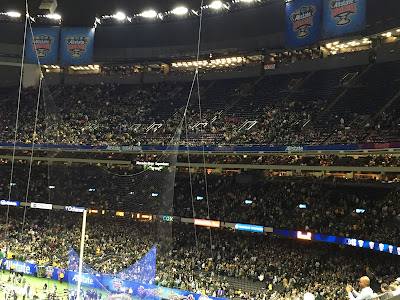There’s simply no excuse for the awful scheduling of the New
Year’s Six bowls and the college football playoff.
From year one, it was painfully obvious to everyone involved
that college football fans want to watch the biggest games on New Year’s Day.
In the just-concluded decade of the 2010s, the top 10 list of college football telecasts includes four semifinal games, from 2014 and 2017 when the semifinals
fell on the first of the year. Each game surpassed multiple actual title games.
This does not make sense. No other sport on the planet sees
more viewers for its semifinals than its finals. But college football has never
made sense.
When the four-team playoff launched, there was doom and gloom
about the new format. Six years later, the format has worked to perfection.
There have been no glaring omissions from the playoffs, despite some minor
debates. The title game every year has crowned a legit champion. Split national
titles are a thing of the past.
Still, the New Year’s Six scheduling is ruining bowl season.
In 2015 and 2016, the insane decision to play semifinal games on New Year’s Eve
backfired spectacularly. In 2018 and 2019, the decision to play the semifinal
games on the Saturday before New Year’s Day improved things slightly, but devalued just about every bowl game after it.
It is not difficult to figure out why. The semifinals
should be the culmination of the bowl season, not the opening act. When Conor
McGregor returns to the ring this month, he will be fighting last. He will not
fight before three other matches, like Clemson/Ohio St this year.
Thankfully, it takes only two very easy steps to fix this
nonsense once and for all, while keeping the Rose and Sugar Bowl games on New
Year’s Day.
Step 1: Switch Up The Rotation
The pairing of the Sugar and Rose as semifinal locations
created myriad problems. For one, it led to New Year’s Day hosting the semifinals
once every three years. Secondly, it ruined other New Year’s Six matchups by
locking too many teams into too many bowl games.
On the semifinal front, the fix is simple. Divide the Rose
and Sugar Bowl games with the others that can be played early on New Year’s Day
– the Rose goes with the Peach, and the Sugar goes with the Cotton. Instantly,
New Year’s Day gets the playoffs twice every year.
For the third year, the Orange Bowl is paired with the
Fiesta Bowl, and step two will take care of the scheduling.
This also ends the imbalance of at-large berths in the New
Year’s Six. As we saw this year, with only one at-large berth. With this new
split, the four non-semifinals will be evenly split between “host” bowls with
strict tie-ins and “access” bowls without tie-ins. That gives the playoff
committee four open slots each and every year to ensure much better bowl matchups.
Step 2: Look at the Calendar
For the 2020 playoffs, the semifinals return to New Year’s Day, which sounds great. And it is. But it’s a Friday, which means Saturday is
January 2nd and a day free of NFL football. That’s when the playoffs should be
played! The calendar is giving college football a free square and they are
missing it, so the following year, the playoffs return to (ugh) New Year’s Eve
on a Friday afternoon. Why are they doing this?
If you can play the semifinals on New Year’s Day twice every
three years, then look to the calendar for finding the best way to schedule the
Orange and Fiesta semifinal games.
It becomes very easy:
- Friday New Year’s Day = playoffs on Saturday Jan. 2, as part of the holiday weekend
- Monday New Year’s Day = playoffs on Saturday, Dec. 30, as part of the holiday weekend
- Thursday New Year’s Day = playoffs on Friday, Jan. 2, as part of the holiday weekend
The calendar will give college football at least one of
these during every three-year cycle, so plan the Orange and Fiesta Bowls around
that, and schedule the other games accordingly. Never again would the college
football playoffs land on New Year’s Eve or a non-holiday weekend.
Since the next six-year cycle is already set in stone, let’s
look at how this plays out starting with the 2026 season. Take a look at this
schedule and tell me this isn’t better than what we have now.
2026 season
Thursday, Dec. 31, 2026
730pm Peach Bowl
730pm Peach Bowl
Friday, January 1, 2027
1pm Cotton Bowl
5pm Rose Bowl
9pm Sugar Bowl
Saturday. January 2, 2028
4pm Fiesta Bowl semifinal
8pm Orange Bowl semifinal
2027 season
Wednesday, Dec. 29. 2027
8pm Fiesta Bowl
Thursday, Dec. 30, 2027
8pm Orange Bowl
Friday, Dec. 31, 2027
730pm Peach Bowl
Saturday, January 1, 2028
1pm Cotton Bowl semifinal
5pm Rose Bowl
9pm Sugar Bowl semifinal
2028 season
Friday, Dec. 29, 2028
8pm Cotton Bowl
Saturday, Dec. 30, 2029
4pm Fiesta Bowl
8pm Orange Bowl
Monday, January 1, 2029
1pm Peach Bowl semifinal
5pm Rose Bowl semifinal
9pm Sugar Bowl
The next three year-cycle:
2029 season
Saturday, Dec. 29, 2029
4pm Fiesta Bowl
8pm Orange Bowl
Monday, Dec. 31, 2029
730pm Peach Bowl
Tuesday, January 1, 2030
1pm Cotton Bowl semifinal
5pm Rose Bowl
9pm Sugar Bowl semifinal
2030 season
Saturday, Dec. 28, 2030
4pm Fiesta Bowl
8pm Orange Bowl
Monday, Dec. 30, 2030
8pm Cotton Bowl
Wednesday, January 1, 2031
1pm Peach Bowl semifinal
5pm Rose Bowl semifinal
9pm Sugar Bowl
2031 season
Wednesday, Dec. 31, 2031
730pm Peach Bowl
Thursday, January 1, 2032
1pm Cotton Bowl
5pm Rose Bowl
9pm Sugar Bowl
Friday, January 2, 2032
4pm Fiesta Bowl semifinal
8pm Orange Bowl semifinal

I LOVE THIS!
ReplyDelete